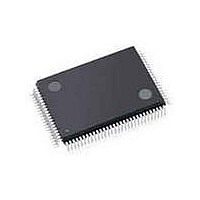C8051F060-TB Silicon Laboratories Inc, C8051F060-TB Datasheet - Page 125

C8051F060-TB
Manufacturer Part Number
C8051F060-TB
Description
BOARD PROTOTYPING W/C8051F060
Manufacturer
Silicon Laboratories Inc
Type
MCUr
Specifications of C8051F060-TB
Contents
Board
Processor To Be Evaluated
C8051F06x
Interface Type
USB
Lead Free Status / RoHS Status
Contains lead / RoHS non-compliant
For Use With/related Products
C8051F060
Lead Free Status / Rohs Status
Lead free / RoHS Compliant
- Current page: 125 of 328
- Download datasheet (2Mb)
C8051F060/1/2/3/4/5/6/7
Programming and Debugging Support
A JTAG-based serial interface is provided for in-system programming of the Flash program memory and
communication with on-chip debug support logic. The re-programmable Flash can also be read and
changed a single byte at a time by the application software using the MOVC and MOVX instructions. This
feature allows program memory to be used for non-volatile data storage as well as updating program code
under software control.
The on-chip debug support logic facilitates full speed in-circuit debugging, allowing the setting of hardware
breakpoints and watch points, starting, stopping and single stepping through program execution (including
interrupt service routines), examination of the program's call stack, and reading/writing the contents of reg-
isters and memory. This method of on-chip debug is completely non-intrusive and non-invasive, requiring
no RAM, Stack, timers, or other on-chip resources.
The CIP-51 is supported by development tools from Silicon Labs and third party vendors. Silicon Labs pro-
vides an integrated development environment (IDE) which interfaces to the CIP-51 via its JTAG port to pro-
vide fast and efficient in-system device programming and debugging. Third party macro assemblers and C
compilers are also available.
13.1. Instruction Set
The instruction set of the CIP-51 System Controller is fully compatible with the standard MCS-51™ instruc-
tion set; standard 8051 development tools can be used to develop software for the CIP-51. All CIP-51
instructions are the binary and functional equivalent of their MCS-51™ counterparts, including opcodes,
addressing modes and effect on PSW flags. However, instruction timing is different than that of the stan-
dard 8051.
13.1.1. Instruction and CPU Timing
In many 8051 implementations, a distinction is made between machine cycles and clock cycles, with
machine cycles varying from 2 to 12 clock cycles in length. However, the CIP-51 implementation is based
solely on clock cycle timing. All instruction timings are specified in terms of clock cycles.
Due to the pipelined architecture of the CIP-51, most instructions execute in the same number of clock
cycles as there are program bytes in the instruction. Conditional branch instructions take one less clock
cycle to complete when the branch is not taken as opposed to when the branch is taken. Table 13.1 is the
CIP-51 Instruction Set Summary, which includes the mnemonic, number of bytes, and number of clock
cycles for each instruction.
13.1.2. MOVX Instruction and Program Memory
In the CIP-51, the MOVX instruction serves three purposes: accessing on-chip XRAM, accessing off-chip
XRAM, and writing to on-chip program Flash memory. The Flash access feature provides a mechanism for
user software to update program code and use the program memory space for non-volatile data storage
(see
Section “16. Flash Memory” on page
177). The External Memory Interface provides a fast access to
off-chip XRAM (or memory-mapped peripherals) via the MOVX instruction. Refer to
Section “17. External
Data Memory Interface and On-Chip XRAM” on page 187
for details.
Rev. 1.2
125
Related parts for C8051F060-TB
Image
Part Number
Description
Manufacturer
Datasheet
Request
R
Part Number:
Description:
SMD/C°/SINGLE-ENDED OUTPUT SILICON OSCILLATOR
Manufacturer:
Silicon Laboratories Inc
Part Number:
Description:
Manufacturer:
Silicon Laboratories Inc
Datasheet:
Part Number:
Description:
N/A N/A/SI4010 AES KEYFOB DEMO WITH LCD RX
Manufacturer:
Silicon Laboratories Inc
Datasheet:
Part Number:
Description:
N/A N/A/SI4010 SIMPLIFIED KEY FOB DEMO WITH LED RX
Manufacturer:
Silicon Laboratories Inc
Datasheet:
Part Number:
Description:
N/A/-40 TO 85 OC/EZLINK MODULE; F930/4432 HIGH BAND (REV E/B1)
Manufacturer:
Silicon Laboratories Inc
Part Number:
Description:
EZLink Module; F930/4432 Low Band (rev e/B1)
Manufacturer:
Silicon Laboratories Inc
Part Number:
Description:
I°/4460 10 DBM RADIO TEST CARD 434 MHZ
Manufacturer:
Silicon Laboratories Inc
Part Number:
Description:
I°/4461 14 DBM RADIO TEST CARD 868 MHZ
Manufacturer:
Silicon Laboratories Inc
Part Number:
Description:
I°/4463 20 DBM RFSWITCH RADIO TEST CARD 460 MHZ
Manufacturer:
Silicon Laboratories Inc
Part Number:
Description:
I°/4463 20 DBM RADIO TEST CARD 868 MHZ
Manufacturer:
Silicon Laboratories Inc
Part Number:
Description:
I°/4463 27 DBM RADIO TEST CARD 868 MHZ
Manufacturer:
Silicon Laboratories Inc
Part Number:
Description:
I°/4463 SKYWORKS 30 DBM RADIO TEST CARD 915 MHZ
Manufacturer:
Silicon Laboratories Inc
Part Number:
Description:
N/A N/A/-40 TO 85 OC/4463 RFMD 30 DBM RADIO TEST CARD 915 MHZ
Manufacturer:
Silicon Laboratories Inc
Part Number:
Description:
I°/4463 20 DBM RADIO TEST CARD 169 MHZ
Manufacturer:
Silicon Laboratories Inc










